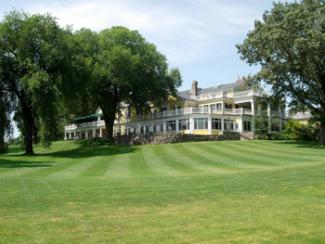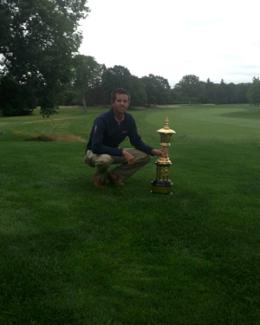Featured Golf News
The Country Club - Where Golf in America Changed Forever
We drove through the tree-lined back streets of Brookline, Mass., passing stately mansions - homes of old Boston money and some new - tucked amid the spreading maples and oaks. We reached the entrance to The Country Club and turned in. What unfolded before us is a pristine and lovely playground of the well-heeled and well-connected, a "country club" in the truest sense of the word.

The Country Club's Stately Clubhouse
Let's put it this way. When all you need to call yourself is The Country Club you've been around for a long time and need no further introductions. I mean, The Country Club has it all, swimming, tennis, curling, a fabulous and rambling, yellow clubhouse, a stately men's locker room, quarters for the staff and, oh yes, one of the most storied golf courses in the world.
Founded in 1882, it is one of the five original founding clubs of the United States Golf Association, along with Newport (R.I.) Country Club, Shinnecock Hills (N.Y.), Chicago Golf Club and St. Andrews Golf Club in New York. The original club focused on horseback riding and other outdoor pursuits; the golf course was not created until 1893.
The Country Club evolved as a collaborative design. In 1893, the initial six holes were crafted by the club's first golf committee, comprised of members Arthur Hunnewell, Laurence Curtis and Robert Bacon. Willie Campbell was hired as the professional in 1894 and helped add three new holes and redesign the original six. The club expanded to 18 holes in 1899. William Flynn designed a third nine in 1927, called Primrose.

Defending U.S. Amateur Champion Steven Fox
(Photos Courtesy of The Country Club)
The course used for championships, including the 2013 U.S. Amateur, is a composite that incorporates three-and-a-half holes from Primrose. Geoffrey Cornish made changes before the 1963 U.S. Open, Rees Jones supervised revisions to the course before the 1988 U.S. Open, and Gil Hanse has done some recent restorations.
History oozes from The Country Club. Three-time Olympic champion and film star Sonja Henie once skated on a frozen pond here, and the club has hosted numerous dignitaries in its hallowed halls. Justin Leonard sank the winning putt in the 1998 Ryder Cup on the club's 17th green, and "The Greatest Game Ever Played" was contested here when, in 1913, a young Francis Quimet crossed the street from his house to The Country Club and beat legendary English pros Harry Vardon and Ted Ray to win the U.S. Open and vault golf into the consciousness of an entire nation. That Open was chronicled magnificently by Mark Frost in his book, "The Greatest Game Ever Played," which was made into an acclaimed movie.
So there we were on such special ground, attending a media day for the 2013 U.S. Amateur that will be played August 12-13 at the club. It's the 113th edition of the Amateur, and the fifth time The Country Club has hosted the event.
I shook hands after a brief discussion session with 21-year-old Steven Fox, the Hendersonville, Tenn., native who made a miracle run of his own last year when he came out of the 63rd seed to win the Amateur by making an 18-foot birdie putt on the first extra hole of the 36-hole championship match with Californian Michael Weaver. In a scenario that would have made the 1913 underdog Quimet proud, Fox had earlier advanced to match play as one of the 14 survivors in a 17-man playoff earlier in the week.
The USGA has cooked up a brutal test of golf for this year's field. The course has been set up at 7,310 yards and is playing to a par of 70. The back nine, get this, will play 3,962 yards, with the ninth through 15th holes perhaps one of the toughest tests we've ever seen. The ninth hole will play as a 505-yard par-4, the 10th a 476-yard par-4, the 11th - what seems in comparison a modest 443-yard par-4, the 12th a beastly 623-yard par-5 (more about this hole later), the 13th a 438-yard par-4, the 14th a 505-yard par-4, and the 15th a 491-yard two-shotter.
If you can somehow get through this stretch at even-par you should receive an honorary membership to The Country Club.
We had a chance to play the course that will be used for the Amateur (nearby Charles River Country Club, a Donald Ross design, will serve as the companion stroke-play qualifying venue for the 300-plus contestants) and I was amazed by its mature beauty. The fairways are immaculate, the greens varied in size, the bunkers plenty and deep, the rough high and the fescue tall enough to be hayed.
We hoofed it out to No. 12 led by our amiable caddie, Brian, on an unusually cool New England summer day. The 12th for us media types was playing as a 560-yard par-5. After a somewhat desultory drive that found the left rough, I was instructed by Brian to punch out just before a steep little hill that held several bunkers and rough deep enough to lose a small dog in. Wise move. My third shot was basically a lay-up because the green was to the left and behind a large tree. My fourth was a nice wedge out of the rough and I two-putted for what seemed like a par but was officially a bogey. I looked back and thought how the hole would play with 60 additional yards tacked on. Ouch.
Our round continued and we basically played for bogey on most of the holes. Their length, even on this day when the tees were up, was too much for my modest game. I did find the greens very fair, without too much undulation and running around 10½ or 11 on the Stimpmeter, as they will be when the Amateur is played.
The front side was much more approachable for the average golfer and, I thought, has some of the coolest holes on the course. The third, a 448-yard par-4, is one of the prettiest holes I've ever encountered. It starts at an elevated tee and then threads between two mounds filled with high fescue to a green protected by bunkers and water at the rear. I hit a solid drive and a 4-wood just short of the green and, of course, proceeded to three-putt. But I managed to make a few pars and flirt with birdie before the skies opened up and the rain drove us from the course after we teed off on the 196-yard par-3 seventh.
(A side note: My group simply had to try and duplicate Leonard's putt at 17, but my attempt was about three feet wide of the mark and would have given the Ryder Cup to the Europeans.)
As Ben Kimball, championship director of the 2013 U.S. Amateur, told us, "The goal of the U.S. Amateur is to identify the best player on a great golf course under difficult conditions."
Well, the USGA doesn't have to worry about that this year. If it rains and/or the wind blows, shooting in the low-70s at The Country Club and making par on most holes in match play will be a stunning accomplishment for the amateurs, even if they're the best in the world.
John Torsiello is an editor/writer living in Connecticut. He has written extensively about all aspects of the golf industry for a number of national and regional publications. He is a regular contributor to "Golf Course Industry," "Lawn and Landscape," "Golfing" and "Fairway Living" magazines as well as various online publications. He has strong, ongoing relationships with industry professionals and has worked closely with course owners, architects, developers, course superintendents and general managers around the country. He has won a number of awards for his writing, including first place from the Turf and Ornamental Communicators Association for a piece that appeared in "Golf Course Industry" magazine.
Story Options
 |
Print this Story |
